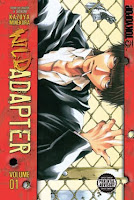 Author: Otsuichi
Author: Otsuichi
Illustrator: Kendi Oiwa
U.S. publisher: Tokyopop
ISBN: 9781427810946
Released: September 2008
Original release: 2003
In Japan, Goth, Kendi Oiwa and Otsuichi’s manga adaptation of Otsuichi’s award-winning novel by the same name, was released in 2003, the year after the original Goth was initially published. Tokyopop released the English translation of Goth, both the manga and the novel, in 2008. However, in this case, the manga was published first, but only by about a month. Although I have since read the original novel, my introduction to the story was through the manga. And since October 2011’s Manga Moveable Feast was focusing on horror manga, I though it would be a good opportunity to review the manga adaptation. It’s a good, creepy manga which I don’t think many people have read. Even though it’s out of print, it doesn’t seem to be too difficult to find yet, and it’s only one volume. I should probably also mention the existence of the 2008 live-action adaptation of Goth, too. I haven’t seen it yet, but I do plan to.
Two high schoolers share an interest in death and murder, although for very different reasons. Morino is a beautiful young woman who is considered strange by her classmates and the other is a young man who is generally well liked. What most people don’t realize is that he is hiding his own aberrant behavior. His friendship with Morino is much more complicated than their classmates know. To him, she is an obsession. Morino might not realize her importance to him at first, but she does come to suspect his darker tendencies. Their relationship is intense and precariously balanced. At any moment, it feels as though he could turn on her or simply allow terrible tings to happen to her. But at the same time his is extremely possessive and protective of Morino. She may be an obsession, but she’s his obsession.
One of the best things about the manga adaptation of Goth is Oiwa’s artwork. Both subtly seductive and vaguely disconcerting, the illustrations fit the story perfectly. Oiwa does very well with the material and even more impressive is that Goth was his first professional work. Oiwa’s page layouts are varied and interesting, the attractive artwork punctuated by panels that are graphic, gruesome, and grotesque. A nice rhythm is set up where these moments aren’t necessarily surprising but everything pauses while the images sink in. The character reactions are very important in these incidents and Oiwa does a fantastic job with facial expressions, or in some cases the deliberate lack thereof. The characters’ expressions reveal a lot about them as people and what is revealed can be a very scary thing. The atmosphere that Oiwa’s art creates paired with Otsuichi’s storytelling is marvelously disconcerting.
Although the original novel is unquestionably the superior of the two, I think the manga is an excellent adaptation and manages to stand well as its own work. The manga incorporates in one way or another five of the original six stories. Changes have been made and not everything from the novel has been used, but the manga never strays from the tone of the original—it is both captivating and disturbing. Its realism and semi-believability make it very, very creepy. Even though I have read both version of Goth several times and the various twists to the plot are no longer surprising to me, they are still effective story elements, revealing just how abnormal some of the characters truly are. And while the manga doesn’t allow the reader to get into their heads to the same extent as the novel, the glimpses seen are chilling. Like the original novel, the manga adaptation of Goth is worth seeking out.




